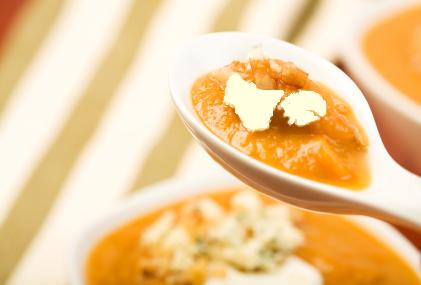
By contributor Erin Jones
Most of you know by now that it’s not what you eat, but how much you eat that controls your weight. French women eat bread, chocolate, foie gras, even rich sauces made from real butter and cream, yet they do not get fat. Pourquoi? Moderation. It’s all about portion control. But actual portion sizes can be a bit tricky. In an age when “super-sized” is the standard, how do you know what a proper serving looks like?
Calculating portions is much easier if you have a visual guide. You may know that a serving of chicken should be about 4 ounces, but how much, exactly, is that? Is the portion of chicken you’ve been enjoying at your favorite restaurant equivalent to a quantity suitable for one person, or three? Quite possibly (and probably) it’s the latter.
We’ve compiled a list of over a dozen foods and paired them with a common household item, for a visual reference to help you understand what a reasonable portion size looks like—whether you’re cooking in your kitchen, savoring a meal at a dinner party, or dining out in a restaurant.
Meat or Poultry (cooked)
Suggested portion: 3 – 4 oz.
Size guide: A deck of playing cards or a computer mouse
Fish (cooked)
3 – 4 oz.
A checkbook, or an eyeglass case
Salad greens
1 cup
Two cupped handfuls
Veggies (raw or cooked)
1/2 cup
Roughly the size of a baseball
Fresh fruit
1 medium piece
A baseball
Bread
1 small slice
A cassette tape
Pancakes and waffles
2 small pancakes or waffles
A compact disc
Pasta
1 cup
Your fist
Rice
1/2 cup
Cupcake wrapper
Potato
A small potato, about 3 oz. (most restaurants serve 6 – 12 ounces of potatoes!)
A bar of soap
Dried cereal
1 cup
Your fist
Dried fruits and nuts
1 oz.
An egg
Cheese
1 1/2 oz.
A large eraser or 4 stacked dice
Yogurt and milk
1 cup
A fist
Ice cream
1/2 cup
1/2 a baseball, or a Clementine
Chocolate
1 oz.
Small package of dental floss
Oil, mayonnaise, and butter
1 teaspoon*
The tip of your thumb
*Most people use far more butter and oil than the standard serving size, 1 teaspoon. For reference, 3 “tips of your thumb” measurements are equal to about one tablespoon.
If you can’t always recall your handy new visual guide, remember: you can always revert to the wisdom of The 50% Solution.
